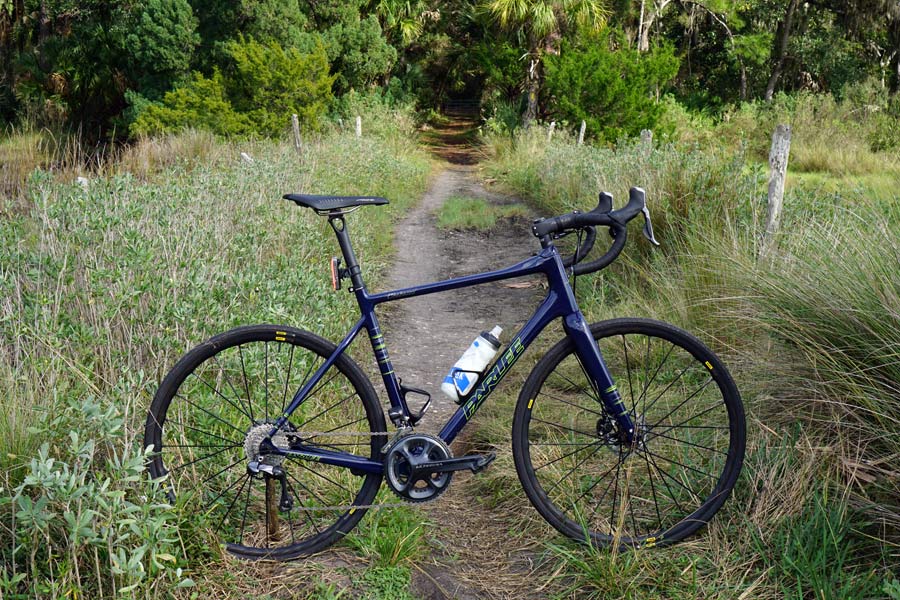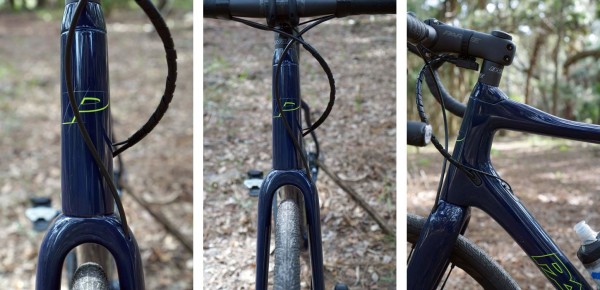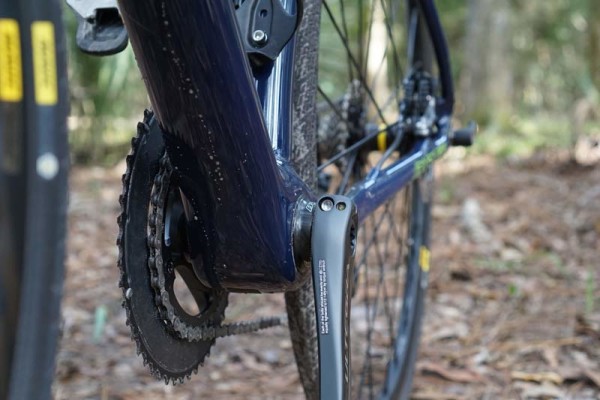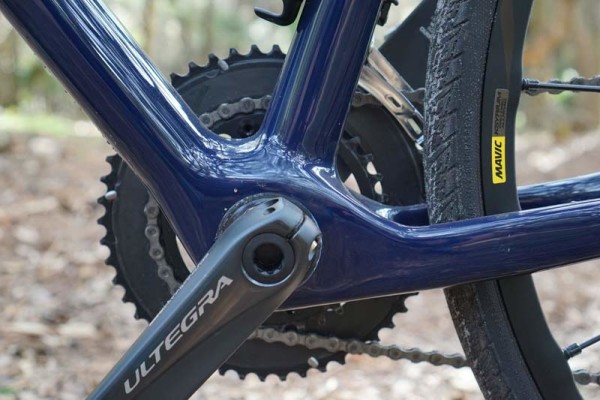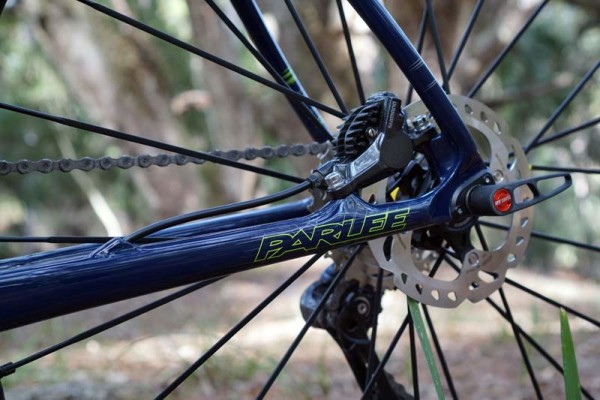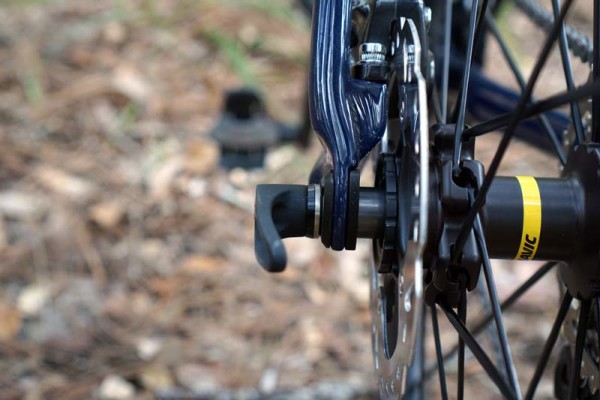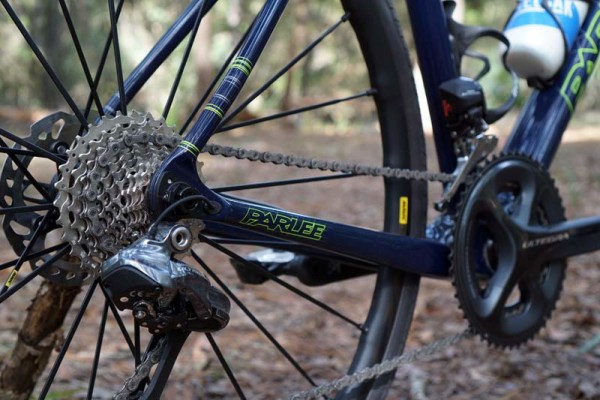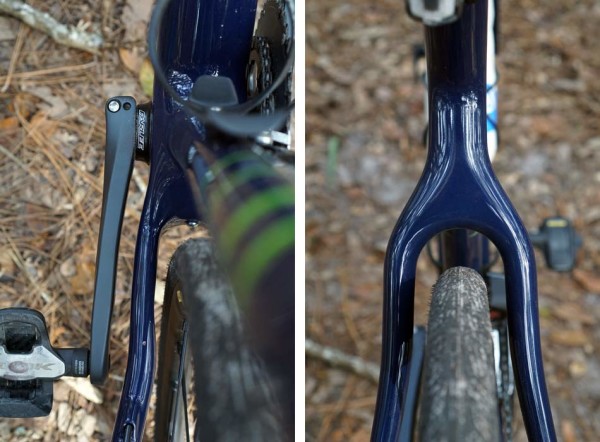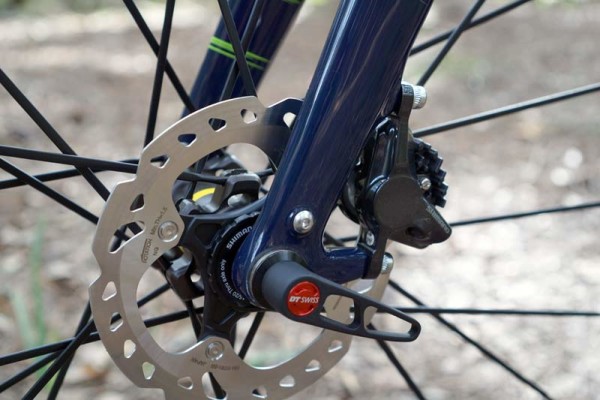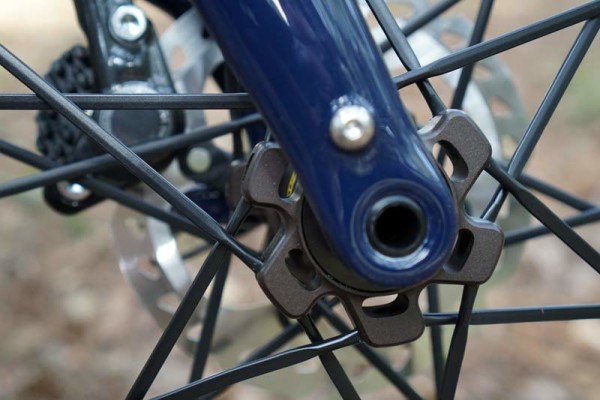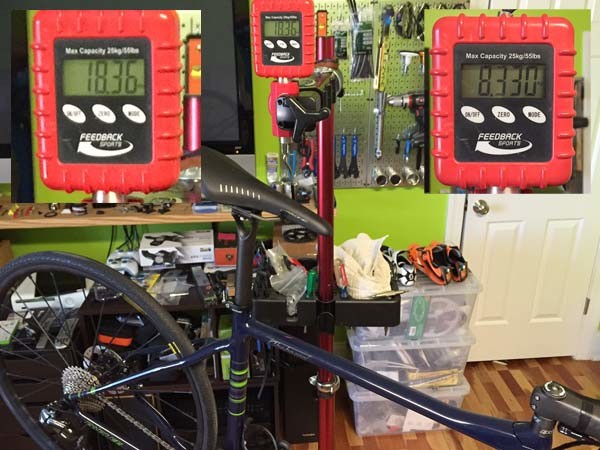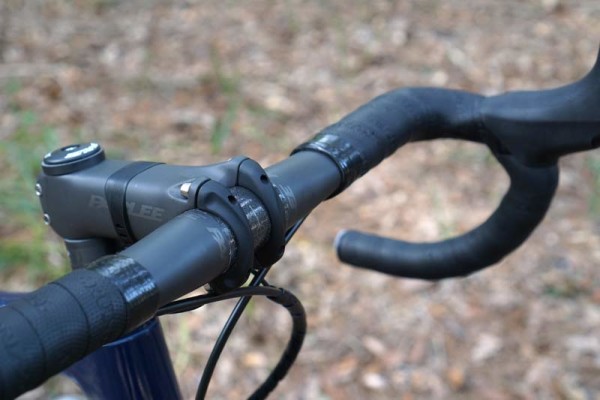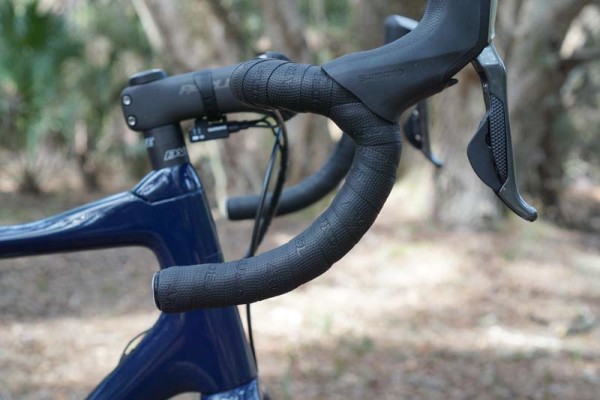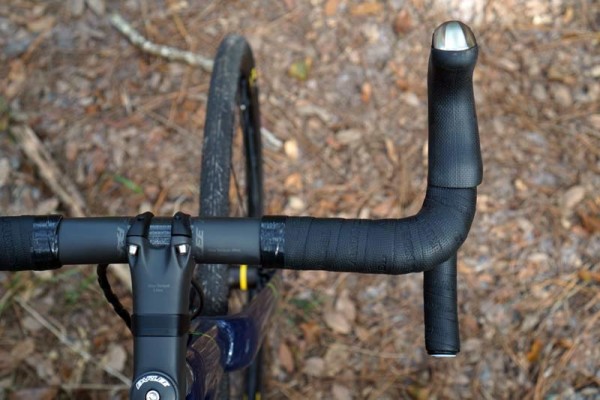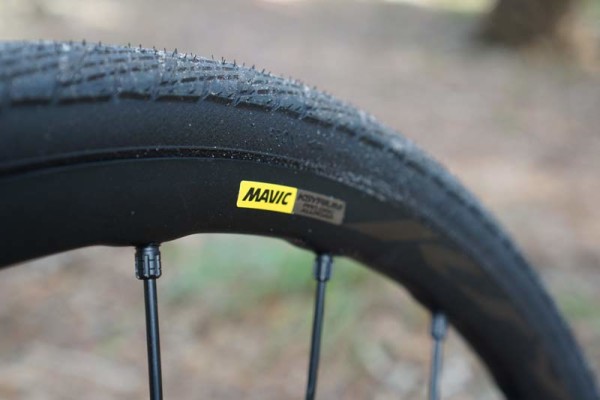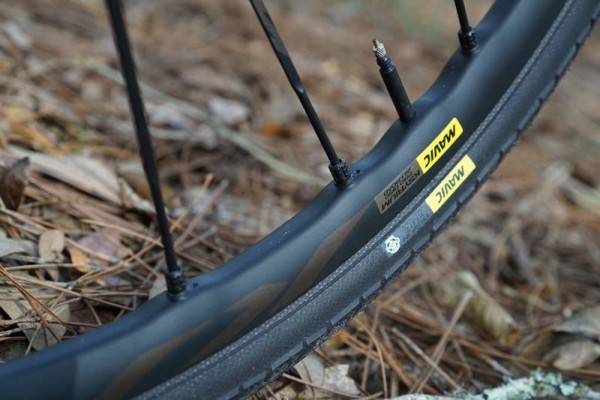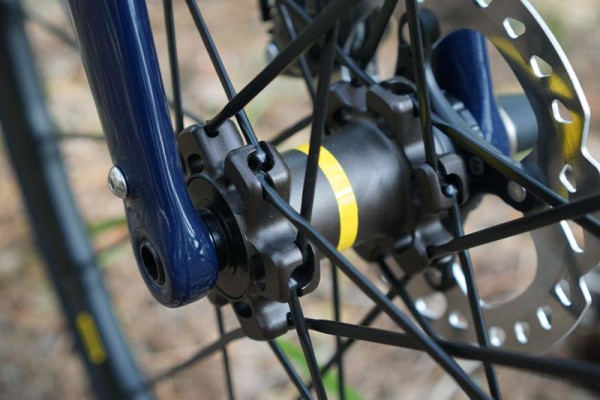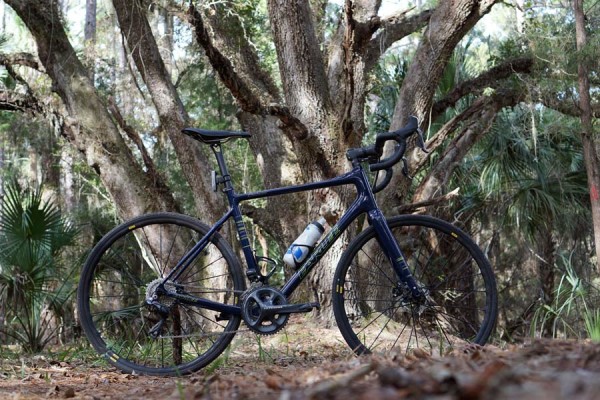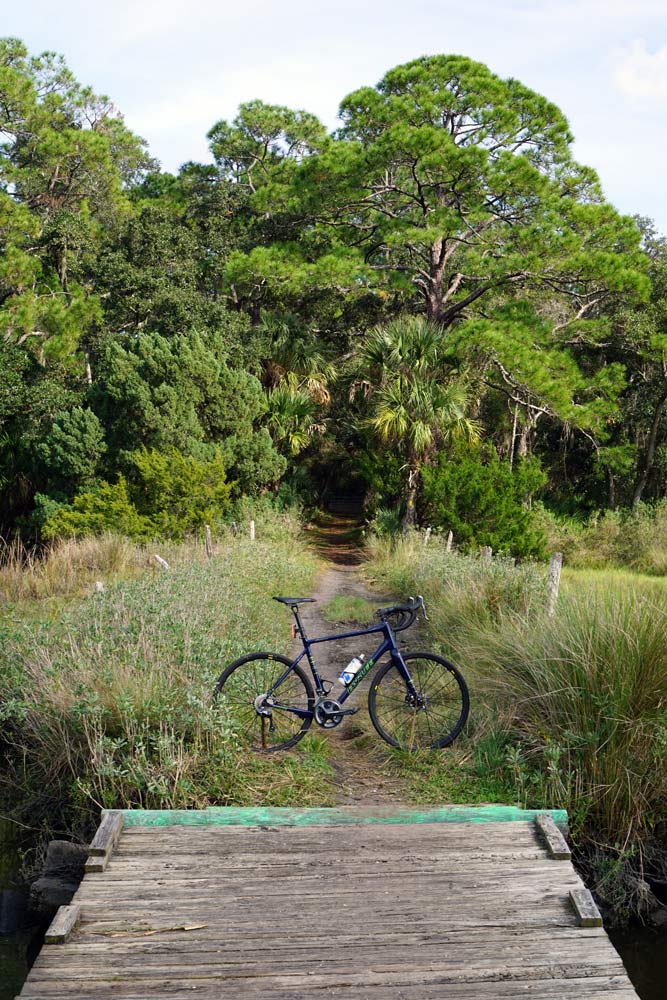Parlee’s Chebacco gravel road bike debuted at Eurobike last fall as the everyman’s version of their full custom Z Zero XD. Its name is no homage to Star Wars’ revival, it’s for the home area of Parlee’s HQ before Massachusetts ever became a state.
As bigger tires and more capable road bikes have grown in popularity, they opted to make something just for the dirt and gravel roads near their manufacturing plant/office they use to test bikes and components. This is that bike, and it’s made a great first impression on the dirt paths and access roads in Tomoka State Park near Flagler Beach, Florida. It also powered along the shoulder of U.S.1 and Old Dixie Highway’s choppy asphalt, using all of Parlee’s high end road bike experience to make it fast regardless of substrate.
Our test bike also came equipped with all new house brand cockpit parts, including carbon stem, handlebar and seatpost, plus the new Mavic Ksyrium Pro All-Road wheels and tires!
Up front, the Chebacco uses Parlee’s versatile headtube design that accommodates both normal and taller riders without resorting to two separate frame designs. The bulged top tube/head tube intersection uses three different height headset spacers to add stack height without making things look weird. For taller riders, this means a much more streamlined look without resorting to inches of spacers on the steerer tube. Yeah, there’s still quite a bit here, but I’m still dialing my position and simply couldn’t wait to get out on a ride.
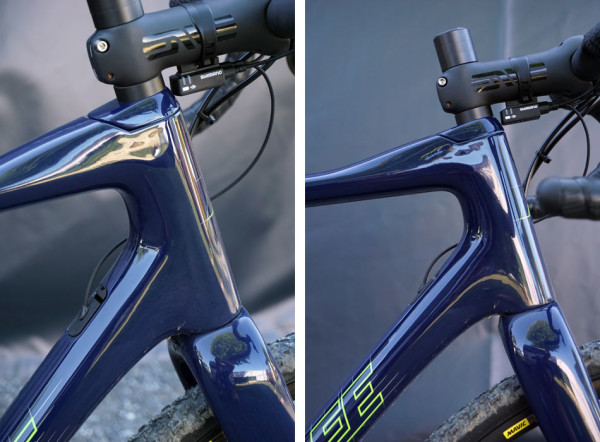
On the downtube is a swappable cable port, using parts specific to the drivetrain set up you’re running. The brake hose enters on the side.
The downtube is big and wide all the way down through the BB, using all available width. It uses a standard PFBB30 shell, and Parlee makes adapters to fit Shimano’s 24mm spindle inside the larger bearings.
A massive BB section ensures all of your effort is driven into the chain rather than frame flex. It’ll hammer happily along with you, but the response to acceleration is a little dependent on how much rubber you’re meeting the road with. It’ll fit up to 40c tires with fenders (using integrated hidden mounts), but the bigger tires take a little more effort to get up to speed. Stupid physics…
The rear brake hose runs internally all the way into the chainstay, popping out far enough ahead of the inside-the-rear-triangle mounts to work with any caliper we’ve seen.
As usual, Parlee’s design is classic but gorgeous Although you’re trading off custom geometry and having it made in America with the Chebacco, you’re also saving about $4,000 to $5,000 and getting an arguably sleeker frame.
Swappable dropouts let you run QR or 12×142 rear axles. The dropouts sandwich the carbon fiber to protect it.
Parlee sent this bike completely built up, using Shimano Ultegra Di2 since they say most of their customers opt for electronic shifting. That said, the Chebacco is available with plenty of mechanical builds, too, starting at $4,399:
- 105 Mechanical/TRP Spyre $ 4,399.00
- Ultegra Mechanical/685 Hydro $ 4,999.00
- Ultegra Di2/785 Hydro $ 5,999.00
- Force 22/CX1 Hydro $ 5,299.00
- Red 22/Hydro $ 6,499.00
- Dura-Ace Mechanical/685 Hydro $ 5,999.00
- Dura-Ace Di2/785 Hydro $ 7,499.00
All complete bikes come standard with a Zipp Service Course cockpit and DT Swiss Spline R23db wheels. Upgrades include the carbon cockpit (+ $900), Mavic Ksyrium Pro All-Road WTS (+ $700) and ENVE 3.4 Disc wheels (+ $2,300). So, our test bike would ring up to $7,769. A frameset is offered for $3,999, which makes zero sense for the U.S. market…and that’s intentional. They want to sell complete bikes, and they’re only offering framesets because some foreign markets need them because import duties/fees/taxes on complete bikes make their framesets more affordable there.
Tire clearance is claimed at 40mm with fenders. Without the rain protection, these 30mm tires are easily swallowed up. Parlee’s monostay helps keep the entire rear end solid. It’s a “modular monocoque” frame, same as the Altum, except with fewer aerodynamic features in favor of a bit burlier design. They say it’s tuned to mitigate vibration even when used with thinner tires, and that it’s designed as a do-it-all bike capable of racing cyclocross, conquering dirt roads and whipping around on group road rides.
Back up front, the fork is their own design and also gets 40mm tire clearance. It ends with a 15mm thru-axle with threads on the drive side.
The bottom accessory bolts are intended for fenders, not load-bearing racks.
Claimed frame weight is ~950g. Our complete bike in size 58 with tubes in the tires weighed in at 18.36lb (8.33kg).
COCKPIT & WHEELS
On the bike is Parlee’s all-new cockpit. They’ve been working on seatposts for many years, using custom designs on the Altum aero road bike, among others. Now, they’ve got their own handlebars and stems to go with them. Here’s how Parlee’s operations manager Tom Rodi explains their genesis:
“We originally began to explore a bar/stem and post option for an somewhat unusual reason, that is many of our clients wanted us to custom paint their bar/stem and post to match their bikes so it didn’t make sense to buy a fully painted set of parts and hand strip them so they could be painted as we were doing but no component maker was really interested in selling us unpainted parts so we started to think about doing our own. Once we started down the path we realized that there were a few things that we wanted from bar/stem/posts that were not available in the market. The most noticeable and arguably important was a handlebar with more full-sized positions to put your hands. We felt many of the bars on the market were too small for most riders in both length and girth so we designed a bar that had more real estate than just about any bar in the market. More hand positions equals more comfort on longer rides. The search for a larger and better shaped top section led us to choosing the newer 35.0mm clamp interface which led us to think about doing a stem that matched.”
That 35mm diameter at the center means I haven’t been able to use my out-front computer mounts, but it does make things stiff. Interestingly, because the rest of the bar is big, too, it’s not immediately obvious it’s a 35mm design.
The stem uses a full carbon body and a two-piece alloy front cap with rear-facing titanium bolts. This was done to avoid threaded inserts molded into the carbon, which can become damaged and ruin the entire stem. What’s unique is the 2º angle used by the bolts, making it easier to get standard hex keys and torque wrenches in there. The steerer clamp bolts thread into separate nuts, not bonded-in threads.
The handlebar uses a slight rearward sweep and ovalized profile on the tops. The drops extend further back than normal to provide a larger platform for your hands and increase available positions. Under the tape, there are cut guides in 5mm increments if you want to shorten it.
The oval shape creates a broad platform whose width runs all the way out to a sharp bend. Drop is 128mm, reach is 70mm. Available in 40, 42 and 44 cm widths (C-to-C). Retail is $375 for the bar, $325 for the stem.
The seatpost design comes straight from their top-of-the-line ESX aero road bike, minus the Recurve aero shaping. It’s a two-bolt design with rounded clamp base that makes adjustments easy but holds the saddle secure. The clamp is designed to work for both round and oblong saddle rails, carbon or metal.
Introduced last summer, the Mavic Ksyrium All-Road wheels are some of their first road bike models to use a wider (19mm) internal profile. Not only does that make them great for gravel, but cyclocross racers now have a more appropriate option from the French brand.
They benefit from ISM4D milling and smoothing to create a 420-430g rim. Claimed wheelset weight is 1620g, price is $1,250 / €1,000.
The front hubs carry over mostly unchanged from recent years, which is good. We’ve found them to be reliable, and Mavic’s included tools make it very easy to adjust bearing preload without even removing the wheel from the bike. In the back, their new 9º engagement system makes things snappier without adding noise.
The bike came with tubes installed, but I’ll be switching them to tubeless for the rest of the test. The Yksion Elite All-Road tires have so far been smooth on the road and capable on Florida’s typically sandy dirt roads, without only a few almost wash outs that flooded my chest with adrenaline for a sec. Fortunately, the combined stiffness of the frame and wheels kept things from going completely sideways and I remained upright, but kids, seriously, watch those sandy patches.
FIRST IMPRESSIONS
My test started on the same paths and roads the Jamis Renegade saw, looping around some of Ormond Beach’s nature trails and forest service roads. To get there requires covering miles of pavement, and I usually add a little distance by taking the long way home. It’s early to make big proclamations, but the Chebacco seems solid and fast, but doesn’t immediately jump out as a viable option for cyclocross. And the geometry bears that out. Compared to the Pivot Vault I’m testing, the chainstay, wheelbase and BB drop are all 0.5cm longer, and the seat tube angle is 0.5º slacker. Those are all very small differences, but they seem to add up to a bike that’s happier cruising along at speed than nimbly navigating course tape.
And happy it is, providing a race-worthy pedaling platform when you want it and a stiff front end when you need it. Handling is stable and predictable, which definitely saved me from a few washouts. It does this without feeling too harsh, which is no small feat considering the beefy fork, oversized 35mm handlebar/stem and a wide 31.6mm seatpost. I’m thinking the switch to tubeless will smooth things over just enough to put it right in the sweet spot.
If you’re a Parlee fan, you’ll feel right at home on it as you stray from the safety of smooth pavement. And if you’re just in the market for something more capable, the numbers (other than price) suggest it’ll match up nicely with the Renegade, which continues to collect kudos. Stay tuned for the long term report this spring.
